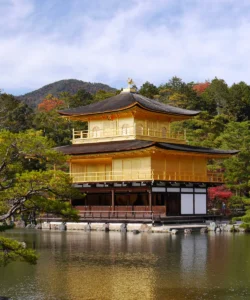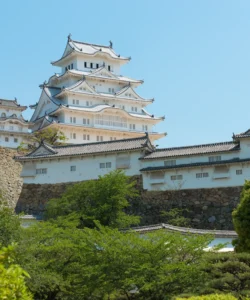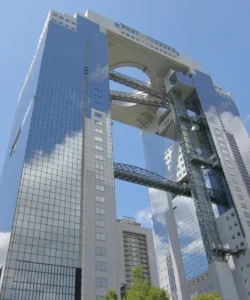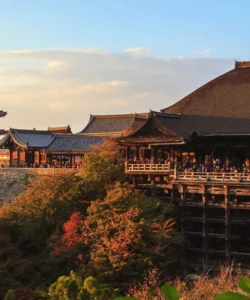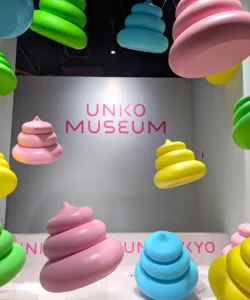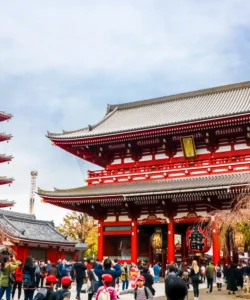Fushimi Inari-taisha (伏見稲荷大社) is arguably Kyoto’s most visually striking and popular Shinto shrine, instantly recognizable for its thousands of vibrant vermilion torii (shrine gates) that snake up the sacred Mount Inari. It serves as the head shrine for over 30,000 Inari shrines located throughout Japan.
Address:
68 Fukakusa Yabunouchi-cho, Fushimi-ku, Kyoto 612-0882, Japan. It is conveniently located right outside Inari Station on the JR Nara Line (a short ride from Kyoto Station) and a short walk from Fushimi-Inari Station on the Keihan Electric Railway.
Outstanding Features:
- Senbon Torii (Thousand Torii Gates): This is the shrine’s most iconic feature. Thousands of closely spaced, brilliant vermilion torii gates form captivating tunnels that wind up the entire 233-meter high Mount Inari. Each gate is a donation from an individual or, more commonly, a Japanese business, hoping for or giving thanks for prosperity. The names of the donors and their donation dates are inscribed on the back of each gate. The sheer scale and visual impact are truly mesmerizing.
- Fox (Kitsune) Statues: Foxes are revered as the messengers of Inari Okami, the deity enshrined at Fushimi Inari. Throughout the shrine grounds, you’ll find countless statues of foxes, often depicted holding symbolic items in their mouths or beneath their paws, such as a key (to a rice granary), a jewel, or a scroll. They are frequently adorned with red votive bibs (yodarekake).
- Deity of Rice, Sake, and Business Prosperity: Fushimi Inari-taisha is dedicated to Inari Okami, originally the kami (deity) of rice and agriculture. Over time, as Japan’s economy evolved, Inari became associated with general prosperity, business success, and fertility. This association draws numerous businesses and entrepreneurs who donate torii gates as a form of prayer or gratitude.
- Mountain Hiking Trail: The shrine complex is built on and encompasses the entire Mount Inari. The path through the torii gates extends into a network of trails leading to numerous smaller shrines, stone altars, and viewpoints along the way. A full hike to the summit and back typically takes 2-3 hours, offering a unique blend of spiritual pilgrimage and scenic trekking.
- Panoramic Views of Kyoto: About halfway up the mountain, at the Yotsutsuji intersection, there’s an excellent viewpoint offering panoramic vistas of southwestern Kyoto city.
- Open 24/7 with Free Admission: Unlike many other shrines or temples that have closing times and entrance fees, Fushimi Inari-taisha’s main grounds and the torii gate paths are open 24 hours a day and completely free to enter, allowing for visits at any time, including atmospheric early mornings or illuminated evenings.
- Cultural Experience and Local Delicacies: The approach to the shrine is lined with various shops and food stalls selling souvenirs and local specialties, including kitsune udon (fox udon, topped with fried tofu, a favorite of foxes) and tsujiura senbei (a type of fortune cookie believed by some to be the origin of the American fortune cookie).
Comparison with Similar Locations:
Fushimi Inari-taisha is arguably one of the most unique and recognizable Shinto shrines in Japan, setting it apart from many others:
- Scale of Torii Gates: While many Shinto shrines feature torii gates at their entrance, no other shrine in Japan (or the world) boasts the sheer number and density of vermilion torii gates that stretch for kilometers up a mountain as seen at Fushimi Inari-taisha. This creates a truly immersive and iconic visual experience.
- Central Role to a Specific Deity: As the head shrine for all Inari shrines, Fushimi Inari-taisha holds a unique hierarchical position within Japan’s Shinto landscape. While other major shrines are dedicated to specific kami (e.g., Ise Grand Shrine to Amaterasu Omikami, Izumo Taisha to Okuninushi), Fushimi Inari’s widespread network of branch shrines dedicated to Inari makes it distinct.
- Integration of Nature and Pilgrimage: While many shrines are set in natural environments (e.g., Itsukushima Shrine on Miyajima with its iconic floating torii and mountain backdrop), Fushimi Inari uniquely combines the spiritual journey with a significant physical hike through its main attraction – the torii tunnels – making the natural ascent integral to the shrine experience.
- Focus on Business and Fortune: While many shrines offer blessings for various aspects of life, Fushimi Inari’s strong association with business prosperity and its history of corporate donations for torii gates give it a particular appeal to entrepreneurs and companies, which might not be as pronounced at shrines primarily focused on imperial lineage (e.g., Meiji Jingu in Tokyo) or specific historical events.
- Accessibility: Despite its mountain setting, its direct access via public transport from Kyoto’s main station makes it highly accessible for tourists, often more so than some grand, but more remotely located, Shinto sites.
In conclusion, Fushimi Inari-taisha is an unparalleled blend of spiritual devotion, natural beauty, and a visually stunning architectural feature that has made it one of Japan’s most captivating and frequently visited sites.


